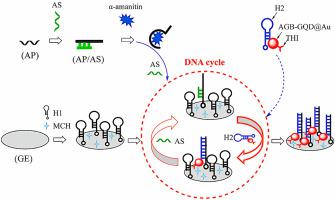Analytica Chimica Acta ( IF 5.7 ) Pub Date : 2022-06-04 , DOI: 10.1016/j.aca.2022.340033 Qiyue Zhu 1 , Ruiyi Li 2 , Xiulan Sun 3 , Li Zaijun 1

|
Poisonous mushroom may cause fatal harm to human and animal, but its rapid detection still faces a great challenge. The paper reports synthesis of gold-aspartic acid, glycine acid-functionalized and boron-doped graphene quantum dot nanohybrid (AGB-GQD@Au) for the electrochemical detection of α-amanitin. AGB-GQD was prepared by pyrolysis and then reacted with chloroauric acid to produce gold nanoparticles. AGB-GQD@Au offers 12.5 nm-sized particles and Schottky heterojunction, improving the catalytic activity. AGB-GQD@Au connected with hairpin DNA and thionine by Au–S bonds was used as redox probe for electrochemical detection of α-amanitin coupled with one target-induced DNA cycle amplification strategy. α-Amanitin specifically hybridizes with aptamer in duplex DNA to release auxiliary strand DNA. The released DNA triggers one DNA cycle process and brings one redox probe to the electrode surface. By the DNA cycle, one target brings many redox probes to the electrode surface, producing a significant signal amplification. The detection signal was further enhanced by the catalysis of AGB-GQD@Au towards redox of thionine. Differential pulse voltammetric current increases linearly with the increasing α-amanitin in the range from 4 to 4 × 105 fM with the detection limit of 1.2 fΜ (S/N = 3). The analytical method provides advantages of sensitivity, selectivity and repeatability. It has been successfully applied in electrochemical detection of α-amanitin in blood.
中文翻译:

具有金-天冬氨酸、甘氨酸功能化和硼掺杂石墨烯量子点纳米混合物的高灵敏度和选择性电化学适体传感器用于检测血液中的α-鹅膏菌素
毒蘑菇可能对人畜造成致命伤害,但其快速检测仍面临巨大挑战。该论文报道了金-天冬氨酸、甘氨酸功能化和硼掺杂的石墨烯量子点纳米杂化物(AGB-GQD@Au)的合成,用于电化学检测α-鹅膏菌素。AGB-GQD通过热解制备,然后与氯金酸反应生成金纳米颗粒。AGB-GQD@Au 提供 12.5 nm 大小的颗粒和肖特基异质结,提高了催化活性。AGB-GQD@Au 通过 Au-S 键与发夹 DNA 和亚硫氨酸连接,用作氧化还原探针,用于电化学检测 α-鹅膏菌素,并结合一种靶标诱导的 DNA 循环扩增策略。α-Amanitin 与双链 DNA 中的适体特异性杂交以释放辅助链 DNA。释放的 DNA 触发一个 DNA 循环过程,并将一个氧化还原探针带到电极表面。通过 DNA 循环,一个目标将许多氧化还原探针带到电极表面,产生显着的信号放大。通过 AGB-GQD@Au 对亚硫氨酸氧化还原的催化作用进一步增强了检测信号。差分脉冲伏安电流随着 α-鹅膏菌素的增加而线性增加,范围为 4 至 4 × 105 fM,检测限为 1.2 fM (S/N = 3)。该分析方法具有灵敏度、选择性和可重复性的优点。它已成功应用于血液中α-鹅膏菌素的电化学检测。









































 京公网安备 11010802027423号
京公网安备 11010802027423号